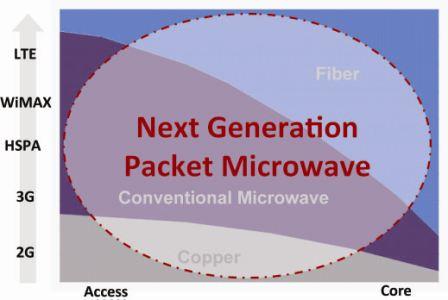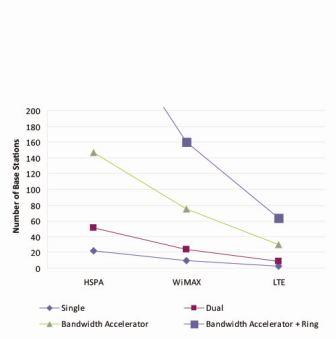Getting the backhaul right is always about making calculated tradeoffs between technologies in order to deliver the optimal balance of cost and performance. Unfortunately the parameters of the available products keep on changing, so you have to keep on re-evaluating your options.
Copper as a backhaul solution for 3G-plus services (i.e. HSPA, WiMAX, LTE) is pretty much a non starter, due to the low bandwidth available per circuit and the resulting high cost per bit. This much hasn’t changed. At the edge of the network it is fairly well established that if you have fiber in place then it makes sense to use it. If you do not have access to fiber, and require a build longer than 1000 feet or so, it makes more sense to put in a packet microwave link. Microwave can easily deliver the required capacity to serve a single base station, and the cost to install and maintain the link is distance independent for spans up to several kilometers long. The cost of building the fiber (negotiating the right of way, digging up the ground, laying new fiber) is proportional to the distance of the connection and local conditions. Since the average link length in a metro area is 2 to 3 miles, it is easy to see that the majority of new connections (or replacement of copper connections) will be packet microwave. Again, not much has changed here.
When several base stations are aggregated together, the capacity required may exceed the capability of a single packet microwave link. The number of base stations that can be aggregated before this limitation is reached will vary depending on the radio access technology (and the resultant bandwidth per base station), the statistical multiplexing assumptions, and the topological diversity; rings and mesh provide more available paths back to the aggregation point than 1+1 links and hence have a higher capacity carrying capability. When the single link capacity is exceeded, the choice is either to deploy another link in parallel, or to switch to fiber. Something has changed here.
Recently Gbps-plus microwave links, operating in the 60 to 90 GHz range, have become available. These links can typically support relatively short distances (less than 1 mile), yet due to network topology, link spans of up to 6 miles are required to reach the majority of base stations. This means the 60 to 90 GHz products can only address a small subset of the backhaul network, making them a niche solution. Packet radios operating in the 6 to 38 GHz licensed bands are capable of covering the required distances; however these are limited in throughput by the size of RF channels available. A single 50 MHz channel – the largest routinely available in North America – can support approximately 400 Mbps of sustained throughput. In order to deliver additional capacity, these radios combine multi-carrier operation with digital processing techniques to get improvements in spectral efficiency. The highest capacity of this type of radio announced to date is up to 4 Gbps per link.

The graph below shows the number of base stations that can be aggregated on a single microwave link using various packet microwave technologies: a single channel system, a dual channel system, a dual channel system with digital signal processing to improve the spectral efficiency (bandwidth accelerator), and finally such a system with a ring topology rather than a linear hub and spoke system. In all cases the statistical multiplexing efficiency is proportional to the number of base stations served and maxes out at 3 to 1 oversubscription. These aggregation sub-networks would be used to backhaul the base station traffic to a fiber point of presence. As can be seen, the advances in packet microwave can deliver not only last mile access, but aggregation for almost any sized network, including LTE.
Microwave has clearly come a long way in terms of capacity, reach, reliability and networkability in the past few years. These attributes, combined with lower cost and increased flexibility, are giving network designers the opportunity to rethink some of their default technology choices.
With the throughput levels we are now seeing – in a technology that meets all the requirements of next generation networks – the competition between packet microwave and fiber just got a lot more interesting.

Dr. Alan Solheim, Vice President of Product Management at DragonWave, is author of MobilityTechzone’s The Middle Mile column. To read more of Alan’s articles, please visit his columnist page.
Edited by
Erin Harrison QUICK LINKS
QUICK LINKS